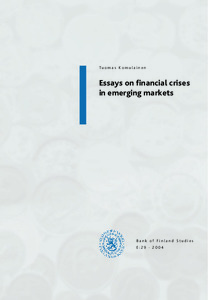Essays on financial crises in emerging markets
Komulainen, Tuomas (01.02.2004)
Numero
29Julkaisija
Suomen Pankki
2004
Julkaisun pysyvä osoite on
https://urn.fi/URN:NBN:fi:bof-201408071689Tiivistelmä
The financial crises in emerging markets in 1997-1999 were preceded by financial liberalisation, rapid surges in capital inflows, increased levels of indebtedness, and then sudden capital outflows. The study contains four essays that extend the different generations of crisis literature and analyse the role of capital movements and borrowing in the recent crises. Essay 1 extends the first generation models of currency crises.It analyses bond financing of fiscal deficits in domestic and foreign currency, and compares the timing and magnitude of attack with the basic case where deficits are monetised.The essay finds that bond financing may not delay the crisis.But if the country's indebtedness is low, the crisis is delayed by bond financing, especially if the borrowing is carried out with bonds denominated in foreign currency. Essay 2 extends the second generation model of currency crises by adding capital flows.If these depend negatively on crisis probability, there will be multiple equilibria.The range of country fundamentals for which self-fulfilling crises are possible is wider when capital flows are included, and thus more countries may end up in crisis.An application of the model shows that in 1996 in many emerging economies the fundamentals were inside the range of multiple equilibria and hence self-fulfilling crises were possible. Essay 3 studies financial contagion and develops a model of the international financial system.It uses a basic model of financial intermediation, but adds several local banks and an international bank.These banks are able to use outside borrowing, the amount of which is determined by the value of their collateral.The essay finds that the use of leverage by local and global banks and the fall in collateral prices comprise an important channel and reason for contagion. Essay 4 analyses the causes of financial crises in 31 emerging market countries in 1980.2001.A probit model is estimated using 23 macroeconomic and financial sector indicators.The essay finds that traditional variables (eg unemployment and inflation) and several indicators of indebtedness (eg private sector liabilities and banks. foreign liabilities) explain currency crises.When the sample was divided into pre- and post-liberalisation periods, the indicators of indebtedness became more important in predicting crisis in the post-liberalisation period. Key words: currency crises, banking crises, emerging markets, borrowing, collateral, contagion, liberalisation
